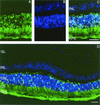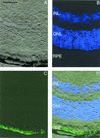Virus-mediated transduction of murine retina with adeno-associated virus: effects of viral capsid and genome size
- PMID: 12097579
- PMCID: PMC136354
- DOI: 10.1128/jvi.76.15.7651-7660.2002
Virus-mediated transduction of murine retina with adeno-associated virus: effects of viral capsid and genome size
Abstract
Gene therapy vectors based on adeno-associated viruses (AAVs) show promise for the treatment of retinal degenerative diseases. In prior work, subretinal injections of AAV2, AAV5, and AAV2 pseudotyped with AAV5 capsids (AAV2/5) showed variable retinal pigmented epithelium (RPE) and photoreceptor cell transduction, while AAV2/1 predominantly transduced the RPE. To more thoroughly compare the efficiencies of gene transfer of AAV2, AAV3, AAV5, and AAV6, we quantified, using stereological methods, the kinetics and efficiency of AAV transduction to mouse photoreceptor cells. We observed persistent photoreceptor and RPE transduction by AAV5 and AAV2 up to 31 weeks and found that AAV5 transduced a greater volume than AAV2. AAV5 containing full-length or half-length genomes and AAV2/5 transduced comparable numbers of photoreceptor cells with similar rates of onset of expression. Compared to AAV2, AAV5 transduced significantly greater numbers of photoreceptor cells at 5 and 15 weeks after surgery (greater than 1,000 times and up to 400 times more, respectively). Also, there were 30 times more genome copies in eyes injected with AAV2/5 than in eyes injected with AAV2. Comparing AAVs with half-length genomes, AAV5 transduced only four times more photoreceptor cells than AAV2 at 5 weeks and nearly equivalent numbers at 15 weeks. The enhancement of transduction was seen at the DNA level, with 50 times more viral genome copies in retinas injected with AAV having short genomes than in retinas injected with AAV containing full-length ones. Subretinal injection of AAV2/6 showed only RPE transduction at 5 and 15 weeks, while AAV2/3 did not transduce retinal cells. We conclude that varying genome length and AAV capsids may allow for improved expression and/or gene transfer to specific cell types in the retina.
Figures











Similar articles
-
Exchange of surface proteins impacts on viral vector cellular specificity and transduction characteristics: the retina as a model.Hum Mol Genet. 2001 Dec 15;10(26):3075-81. doi: 10.1093/hmg/10.26.3075. Hum Mol Genet. 2001. PMID: 11751689
-
Adeno-associated virus type 5: transduction efficiency and cell-type specificity in the primate retina.Hum Gene Ther. 2003 Nov 20;14(17):1663-71. doi: 10.1089/104303403322542301. Hum Gene Ther. 2003. PMID: 14633408
-
Impact of Heparan Sulfate Binding on Transduction of Retina by Recombinant Adeno-Associated Virus Vectors.J Virol. 2016 Mar 28;90(8):4215-4231. doi: 10.1128/JVI.00200-16. Print 2016 Apr. J Virol. 2016. PMID: 26865709 Free PMC article.
-
Novel adeno-associated viral vectors for retinal gene therapy.Gene Ther. 2012 Feb;19(2):162-8. doi: 10.1038/gt.2011.151. Epub 2011 Oct 13. Gene Ther. 2012. PMID: 21993172 Review.
-
A Comparative Analysis of Models for AAV-Mediated Gene Therapy for Inherited Retinal Diseases.Cells. 2024 Oct 15;13(20):1706. doi: 10.3390/cells13201706. Cells. 2024. PMID: 39451224 Free PMC article. Review.
Cited by
-
Evaluating therapeutic potential of NR2E3 doses in the rd7 mouse model of retinal degeneration.Sci Rep. 2024 Jul 17;14(1):16490. doi: 10.1038/s41598-024-67095-6. Sci Rep. 2024. PMID: 39019967 Free PMC article.
-
Comparative analysis of DNA nanoparticles and AAVs for ocular gene delivery.PLoS One. 2012;7(12):e52189. doi: 10.1371/journal.pone.0052189. Epub 2012 Dec 18. PLoS One. 2012. PMID: 23272225 Free PMC article.
-
AAV-mediated human CNGB3 restores cone function in an all-cone mouse model of CNGB3 achromatopsia.J Biomed Res. 2019 Aug 30;34(2):114-121. doi: 10.7555/JBR.33.20190056. J Biomed Res. 2019. PMID: 32305965 Free PMC article.
-
Self-complementary adeno-associated virus vectors containing a novel liver-specific human factor IX expression cassette enable highly efficient transduction of murine and nonhuman primate liver.Blood. 2006 Apr 1;107(7):2653-61. doi: 10.1182/blood-2005-10-4035. Epub 2005 Dec 1. Blood. 2006. PMID: 16322469 Free PMC article.
-
Targeted transgene expression in muller glia of normal and diseased retinas using lentiviral vectors.Invest Ophthalmol Vis Sci. 2007 Apr;48(4):1844-52. doi: 10.1167/iovs.05-1570. Invest Ophthalmol Vis Sci. 2007. PMID: 17389520 Free PMC article.
References
-
- Ali, R. R., M. B. Reichel, M. De Alwis, N. Kanuga, C. Kinnon, R. J. Levinsky, D. M. Hunt, S. S. Bhattacharya, and A. J. Thrasher. 1998. Adeno-associated virus gene transfer to mouse retina. Hum. Gene Ther. 9:81-86. - PubMed
-
- Auricchio, A., G. Kobinger, V. Anand, M. Hildinger, E. O'Connor, A. M. Maguire, J. M. Wilson, and J. Bennett. 2001. Exchange of surface proteins impacts on viral vector cellular specificity and transduction characteristics: the retina as a model. Hum. Mol. Genet. 10(26):3075-3081. - PubMed
-
- Bennett, J., D. Duan, J. F. Engelhardt, and A. M. Maguire. 1997. Real-time, noninvasive in vivo assessment of adeno-associated virus-mediated retinal transduction. Investig. Ophthalmol. Vis. Sci. 38:2857-2863. - PubMed
-
- Bennett, J., A. M. Maguire, A. V. Cideciyan, M. Schnell, E. Glover, V. Anand, T. S. Aleman, N. Chirmule, A. R. Gupta, Y. Huang, G.-P. Gao, W. C. Nyberg, J. Tazelaar, J. Hughes, J. M. Wilson, and S. G. Jacobson. 1999. Stable transgene expression in rod photoreceptors after recombinant adeno-associated virus-mediated gene transfer to monkey retina. Proc. Natl. Acad. Sci. USA 96:9920-9925. - PMC - PubMed
Publication types
MeSH terms
Substances
Grants and funding
LinkOut - more resources
Full Text Sources
Other Literature Sources

